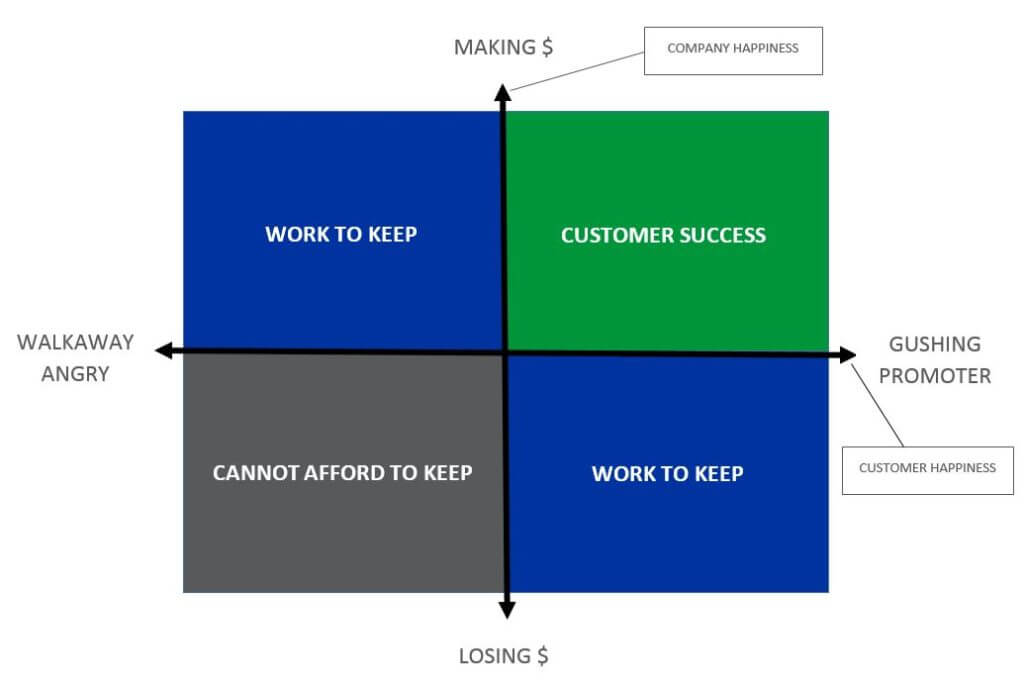How to Establish and Maintain Customer Success
Since the time of the first sale, having satisfied customers has been important. Why? Because selling more is better and selling to an existing customer is easier than finding a new one. Few dispute this. The natural conclusion is that happy customers buy more. True? For the most part. However, I’ve known customers who continue to buy because they felt as if they had no alternative. Their decision had little to do with happiness and sometimes occurred while sorely lacking it. Some even had competitive alternatives and still felt backed into a corner for a combination of financial, time investment, or product compatibility reasons.
Will these dissatisfied customers stay for the long haul? Any chance to sell a follow-on solution? Will they advocate for our company? Can we get candid feedback about our solution? The answer to these questions is, of course, no. And worse, they are likely advocating AGAINST our company.
I mentioned this challenge last time when I drew out a model for the relationship between customer success and company success. A mutually “happy” relationship is necessary to maintain customer success; happy customers will trust us with more or extended services, and that growth then allows us to return enhanced quality support for our customers. So what can Source do for those who are in the blue “Work to Keep” quadrants? Our objective is to increase the “success” of both Source and our customers so that we can move their status into the green “Customer Success” quadrant. I have identified four goals to meet this objective and I will expand on the first two in this post.
- Minimize churn and maximize longevity
- Increase our solution footprint
- Turn our customers into advocates
- Develop a customer feedback loop

Minimize Churn & Maximize Longevity
Our primary goal is to minimize customer turnover and to retain our customers for as long as possible. This is widely recognized as the primary goal of Customer Success. To answer why, let’s look through the lens of history. In the “olden” days of large capital expenditures, customer retention was an issue, but the lifespan of a problem was perceived in years rather than months with the era of anything-as-a-service (XaaS). When customers acquired systems that have a three to seven-year life span, they had to find a way to make their investment work or face the consequences. They took on the success responsibility directly to ensure that their chosen solution worked for their company. If it didn’t, the sponsors had to live with a poor choice until some later time when the solution was depreciated or some other business inflection opened a door for change.
Now contrast that with the world today. Many solutions are enabled with anything-as-a-service models and the narrative has changed. Clients pay subscription fees for desired solutions lessening their financial burden. If a poor decision is made for one reason or another, it’s much easier to move to a competitor if they are unhappy. With a monthly subscription it’s really simple. Certainly, an extra 4-5 years of revenue is significant and that’s why it’s crucial to keep today’s customers happy. Success ownership is now a business problem because our happiness depends on it.
Increase Solution Footprint
A second goal is to increase our solution footprint. We selfishly want to become as sticky as possible in our customer’s world. By understanding their business as well as they do, we become a trusted advisor and partner in which we learn more about where our solution fits and has expansion potential.
In a standard customer/vendor relationship, companies are often uncomfortable asking their client to do things differently for fear of damaging the relationship. Customers, however, rarely feel this way. A sign of a healthy relationship is when we feel at ease to have a “let’s think about this differently” discussion with our partner who is open to that. Each party should be viewed as an extension of the other’s team. Our goal is win-win: Increase happiness with our solution while lifting business happiness by making it more difficult to switch to a competitor.
There are 3 facets to increasing our solution footprint:
- Increase depth & breadth of feature set use. Every customer goes through a solution learning curve and many stop before realizing the full potential. It is said that most customers use only 10%-15% of available features. If we demonstrate how some of the under-used features can be of benefit, we become stickier.
- Find adjacent business opportunities. Our trusted advisor status helps us to understand where we can add value to additional (likely adjacent) areas of our customer’s business. By showing how to solve a business problem perhaps not considered before we expand our footprint and become stickier.
- Accelerate the velocity and realized benefits of our solution. The goal is to minimize friction and get our customer so comfortable with our solution so that they (knowingly or not) push more and more of their business through it at an increasingly faster rate.
The key to all of these is being that trusted advisor. Show them the value. Show them the savings. Break down barriers to use. Increase adoption. If we attain that level of relationship, we are almost guaranteed to increase customer happiness and our stickiness.
Our goal in attaining the status of trusted advisor is that our customers will advocate for our business because they are so pleased with the service they have received. And ideally feedback should not travel in only one direction; accepting our customer’s honest feedback is just as valuable to us as our feedback can be to them.
We’ll expand on each of these goals next time.
To keep up with all of Source’s latest news and conversation, follow us on Twitter, Facebook, or LinkedIn.


